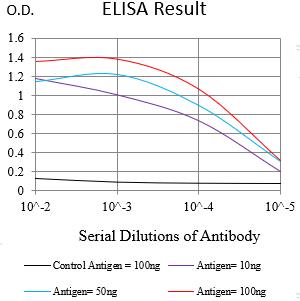
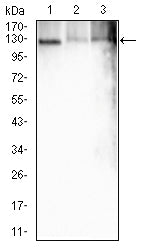
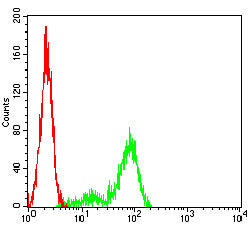
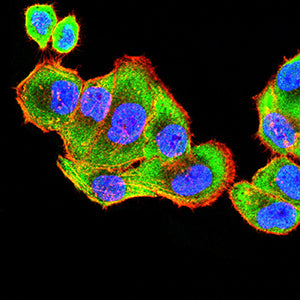
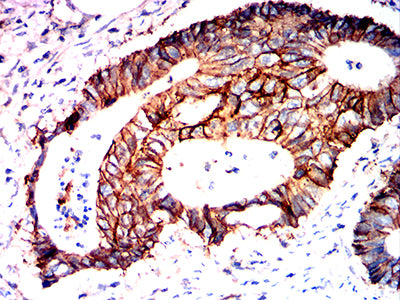

| WB | 咨询技术 | Human,Mouse,Rat |
| IF | 咨询技术 | Human,Mouse,Rat |
| IHC | 1/25-1/100 | Human,Mouse,Rat |
| ICC | 技术咨询 | Human,Mouse,Rat |
| FCM | 咨询技术 | Human,Mouse,Rat |
| Elisa | 1/2000-1/5000 | Human,Mouse,Rat |
| Aliases | CMT2DD; HOMGSMR2 |
| Entrez GeneID | 476 |
| clone | 3C1F3 |
| WB Predicted band size | 112.8kDa |
| Host/Isotype | Mouse IgG2a |
| Antibody Type | Primary antibody |
| Storage | Store at 4°C short term. Aliquot and store at -20°C long term. Avoid freeze/thaw cycles. |
| Species Reactivity | Human |
| Immunogen | Purified recombinant fragment of human ATP1A1 (AA: 153-288) expressed in E. Coli. |
| Formulation | Purified antibody in PBS with 0.05% sodium azide |
+ +
以下是关于LOXL2抗体的3篇代表性文献,按研究领域分类简要总结:
---
1. **文献名称**: *"Lysyl oxidase-like 2 (LOXL2) is critical for tumor microenvironment and metastasis in breast cancer"*
**作者**: Sánchez-Ortega M, et al.
**摘要**: 该研究通过LOXL2特异性抗体(如ABT-100)在乳腺癌模型中发现,抑制LOXL2可显著减少肿瘤相关纤维化和转移,揭示了LOXL2通过调节细胞外基质重塑促进肿瘤微环境形成的机制。
2. **文献名称**: *"A novel monoclonal antibody targeting LOXL2 inhibits cardiac fibrosis in mice"*
**作者**: Li Y, et al.
**摘要**: 作者开发了一种靶向LOXL2的单克隆抗体(mAb210),并在小鼠心肌纤维化模型中验证其疗效,结果显示该抗体通过阻断LOXL2的酶活性减轻胶原沉积和心脏功能损伤。
3. **文献名称**: *"LOXL2 in epithelial-mesenchymal transition (EMT): Diagnostic and therapeutic implications in hepatocellular carcinoma"*
**作者**: Peng C, et al.
**摘要**: 研究利用LOXL2抗体(如克隆号EPR20047)检测肝癌组织中LOXL2表达,发现其与EMT标志物(如E-cadherin丢失)相关,并提示LOXL2抗体可能作为肝癌预后标志物或治疗靶点。
---
这些文献覆盖了LOXL2抗体在**肿瘤转移**、**纤维化疾病**和**癌症诊断**中的关键作用,可作为研究参考。如需具体实验细节或更近期文献,建议通过PubMed或SciHub进一步检索。
Lysyl oxidase-like 2 (LOXL2) is a member of the lysyl oxidase family, enzymes critical for modifying the extracellular matrix (ECM) by catalyzing cross-linking of collagen and elastin. LOXL2 is involved in ECM remodeling, cell adhesion, and tissue homeostasis, with emerging roles in fibrosis, cancer metastasis, and angiogenesis. Its dysregulation has been linked to pathological conditions, including liver and lung fibrosis, as well as tumor progression in cancers like breast, colorectal, and squamous cell carcinomas.
LOXL2 antibodies are tools used to detect and study the expression, localization, and function of LOXL2 in research and diagnostic contexts. They are essential for immunohistochemistry (IHC), Western blotting (WB), and immunofluorescence (IF) to assess LOXL2 levels in tissues or cell lines, often correlating its overexpression with disease severity or metastatic potential. Therapeutic LOXL2-targeting antibodies (e.g., AB0023. PXS-5332) are under investigation to inhibit enzymatic activity or disrupt LOXL2-mediated ECM stiffening, aiming to block cancer progression or fibrotic processes.
Challenges in antibody development include ensuring specificity due to structural homology among LOXL family members and addressing post-translational modifications that may affect LOXL2 detection. Validated LOXL2 antibodies are crucial for understanding its dual roles in tissue repair and disease, highlighting its potential as a biomarker or therapeutic target in fibrosis and oncology.
×